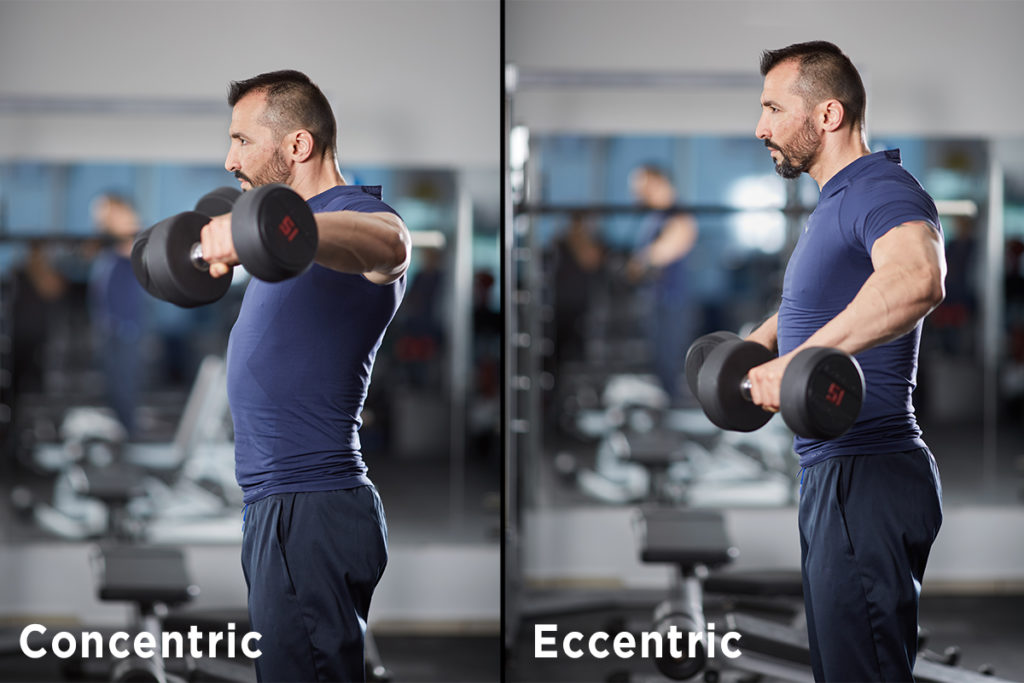5 Eccentric-Training Controversies, Resolved
The positive results of “negative” muscle work.

As we move, muscles provide both positive and negative external work. Positive work is a result of concentric muscle actions (shortening of muscle). Then there are eccentric actions, in which muscle lengthens as resistance becomes greater than the force the muscle is producing—the basis for eccentric training. For example, the lifting phase in a biceps curl exercise is the concentric action, while the lowering phase is the eccentric action.
In exercise and sport, eccentric muscle actions usually decelerate a movement. In downhill running, for instance, the eccentric action of the muscle works like a shock absorber. Yet, the benefits of eccentric training have been much debated. This column will review the results of several investigative studies on controversial topics related to eccentric training.
Hypertrophic Effects of Eccentric Training
Is there a difference in the hypertrophic effects of eccentric versus concentric exercise? In a systematic review and meta-analysis, Schoenfeld et al. (2017) investigated this long-standing controversy.
- The researchers identified 15 studies that all met the following criteria:
- There was an experimental investigation that lasted at least 6 weeks.
- Participants were healthy and not exhibiting any injuries.
- Concentric and eccentric actions were compared without the use of external implements (i.e., blood pressure cuffs).
- Hypertrophy changes were measured using biopsy, imaging (e.g., MRI, computerized tomography or ultrasound), bioelectrical impedance (i.e., small electrical current) or densitometry (i.e., underwater weighing).
Eccentric muscle actions resulted in a greater effect size than concentric actions, but results did not rise to statistical significance. The meta-analysis found that eccentric training produced a 10% increase in hypertrophy compared with a 6.8% improvement from concentric training. The researchers concluded that eccentric and concentric actions are both very effective and important to include in hypertrophy-oriented resistance training programs.
See also: Periodization for Maximizing Hypertrophy
Neuromuscular Adaptations
Almost all studies that have compared eccentric and concentric training have used a fixed number of repetitions and sets in the training programs. However, as noted in Maeo et al. (2018), research has clearly shown that higher (>20%) torque can be produced during eccentric versus concentric contractions.
Maeo et al. observed that in previous trials the positive results (for eccentric training) could have been due to eccentric training groups doing more work. Therefore, the purpose of their own study was to examine neuromuscular adaptations after maximal eccentric versus concentric training when matched for total work.
Twelve male volunteers performed maximal knee extension work on one leg (eccentric leg) versus the other leg (concentric leg), completing two sessions per week for 10 weeks.
The primary finding was that even when total work was matched, eccentric training was more effective in inducing hypertrophy than concentric training. Interestingly, significant changes in hypertrophy were observed in the eccentric leg as early as 4 weeks into the training. Neurological adaptations were also greater in the eccentric leg versus the concentric leg.
Gender-Related Differences
In 2020, Morawetz et al. knew that the acute responses of unaccustomed eccentric exercise lead to temporary strength loss, muscle soreness, muscle damage and higher blood concentrations of creatine kinase (a muscle enzyme that is elevated when there is damage to muscle tissue). However, the researchers could find no accepted evidence that women and men display those effects similarly.
Therefore, Morawetz et al. conducted a systematic review, examining pertinent studies published through May 2018, to evaluate whether there are sex-related differences in how healthy men and women (ages 18–70; no athletes or rehab patients) respond to acute maximal eccentric exercise, specifically in terms of delayed-onset muscle soreness, post-exercise creatine kinase levels and eccentric muscle strength.
Of the original 272 studies in the primary search, 23 studies met complete inclusion criteria for this investigation. Here are some of the interesting findings:
- When torque (the rotational equivalent of linear force) is normalized for muscle cross-sectional area, body mass or fat-free mass, there is no statistically significant difference between women and men.
- Immediately following maximal eccentric exercise, women lose slightly more muscle strength than men in the upper and lower extremities.
- In most trials, men have significantly higher post-exercise creatine kinase levels than women.
- There is no significant difference in post-exercise muscle soreness between the sexes.
These findings suggest that since women tend to lose slightly more strength after maximal eccentric training, personal trainers and coaches should provide them a little more recovery time than men after this type of exercise.
In regard to the higher creatine kinase levels observed in men, the researchers hypothesized the following: Estrogen is known to enhance cell membrane stability, which may reduce leakage of creatine kinase from skeletal muscle into blood. Therefore, estrogen seems to have a protective role against muscle damage.
See also: Training Loads for Women Over 40
Getting the Best Results With Eccentric Training

Fit pros can empower clients to incorporate highly effective eccentric training methods into their daily workouts.
So how hard should people train for the optimal results? In a quest to develop stronger skeletal muscles, there is a great deal of interest in finding the ideal level of eccentric-training intensity for athletes and exercise enthusiasts.
The majority of studies investigating eccentric training have limited applications, as they often focus on highly specific physiological adaptations using a single muscle group on some specialized piece of equipment. These studies do not explain the use of eccentric resistance training as performed in a standard gym setting.
To address this gap, Schroder, Hawkins & Jaque (2004) examined musculoskeletal adaptations in response to an eccentric progressive resistance training protocol consisting of total-body, multiple-muscle-group exercises. Participants used both free weights and standard strength-training machines. Participants were 37 young women volunteers (ages 18–24) who had done no resistance training in the 6 months prior to the study.
In this 16-week investigation, the women were randomly assigned to one of three groups: high-intensity eccentric training (HRT), lower-intensity eccentric training (LRT) or a nonexercise control group. In two training sessions each week, participants completed six exercises: seated chest press, lat pull-down, standing biceps curl, standing triceps extension, seated single-leg extension and seated double-leg curl. All exercises consisted of only eccentric muscle action with no concentric component. This was achieved by having participants lower the weight against gravity (for 4 seconds), while a trainer lifted the weight through the concentric component of the exercise.
The LRT group completed 3 sets of 10 repetitions of each exercise at an intensity equivalent to 75% of their concentric 1-repetition maximum for each exercise. The HRT group completed 3 sets of 6 repetitions at an intensity equal to 125% of their concentric 1-RM. The difference in the number of repetitions (10 versus 6) was to guarantee that the training volume (TV) performed was the same for both groups. TV is calculated in the following manner: intensity x sets x repetitions. Therefore, the TV for the exercise groups was 0.75 x 3 x 10 = 22.5 for the LRT and 1.25 x 3 x 6 = 22.5 for the HRT.
The surprising results of this study demonstrated that LRT (75% of a concentric 1-RM) was as effective as HRT (125% of a concentric 1-RM). Muscular strength in the six exercises increased similarly in both groups, with 20%–40% improvements in maximal strength after 16 weeks of training.
For coaches and trainers, this finding has eye-catching applications. Performing eccentric training with 75% of 1-RM loads allows clients to complete the concentric movements without personal trainer assistance. Fit pros can empower clients to incorporate this highly effective eccentric training method into their daily workouts when a trainer is not present.
Note: This study was conducted with young, untrained women. You may need to modify the program for other populations.
See also: Rehabilitation Breakthroughs With Eccentric Training
Promising Results
In personal training, fitness pros are continually searching for effective training strategies to stimulate adaptive physical changes for their clients. Eccentric exercise has the unique potential to overload the muscular system tremendously, maximizing muscle strength, power and hypertrophy. In view of these promising results, inclusion of eccentric training is encouraged as a viable, evidence-based strategy to further lead clients to goal-oriented successes in training.
Eccentric Exercise Therapy for Critically Ill Patients
In a reflective opinion article, Mitchell et al. (2017) indicate that critically ill patients commonly experience disability due to loss of muscle mass, compromised muscle function and a consequent loss of strength. Muscle mass loss and weakness are major predictors of mortality in older people and in patients with conditions such as chronic obstructive pulmonary disease.
The researchers argue that future advances in managing these critically ill patients should include therapies that minimize the decrement in skeletal muscle function. They conclude that the possible benefits of eccentric training for critically ill patients should be considered in future studies of physical rehabilitation and exercise therapy.
References
Maeo, S., et al. 2018. Neuromuscular adaptations to work-matched maximal eccentric versus concentric training. Medicine & Science in Sports & Exercise, 50 (8), 1629–40.
Mitchell, W.K., et al. 2017. Eccentric exercise and the critically ill patient. Frontiers in Physiology, 8 120.
Morawetz, D., et al. 2020. Sex-related differences after a single bout of maximal eccentric exercise in response to acute effects: A systematic review and meta-analysis. Journal of Strength and Conditioning Research, 34 (9), 2697–707.
Schoenfeld, B.J., et al. 2017. Hypertrophic effects of concentric vs. eccentric muscle actions: A systematic review and meta-analysis. Journal of Strength and Conditioning Research, 31 (9), 2599–608.
Schroeder, E.T., Hawkins, S.A., & Jaque, S.V. 2004. Musculoskeletal adaptations to 16 weeks of eccentric progressive resistance training in young women. Journal of Strength and Conditioning Research, 8 (2), 227–35.
Len Kravitz, PhD
Len Kravitz, PhD is a professor and program coordinator of exercise science at the University of New Mexico where he recently received the Presidential Award of Distinction and the Outstanding Teacher of the Year award. In addition to being a 2016 inductee into the National Fitness Hall of Fame, Dr. Kravitz was awarded the Fitness Educator of the Year by the American Council on Exercise. Just recently, ACSM honored him with writing the 'Paper of the Year' for the ACSM Health and Fitness Journal.






